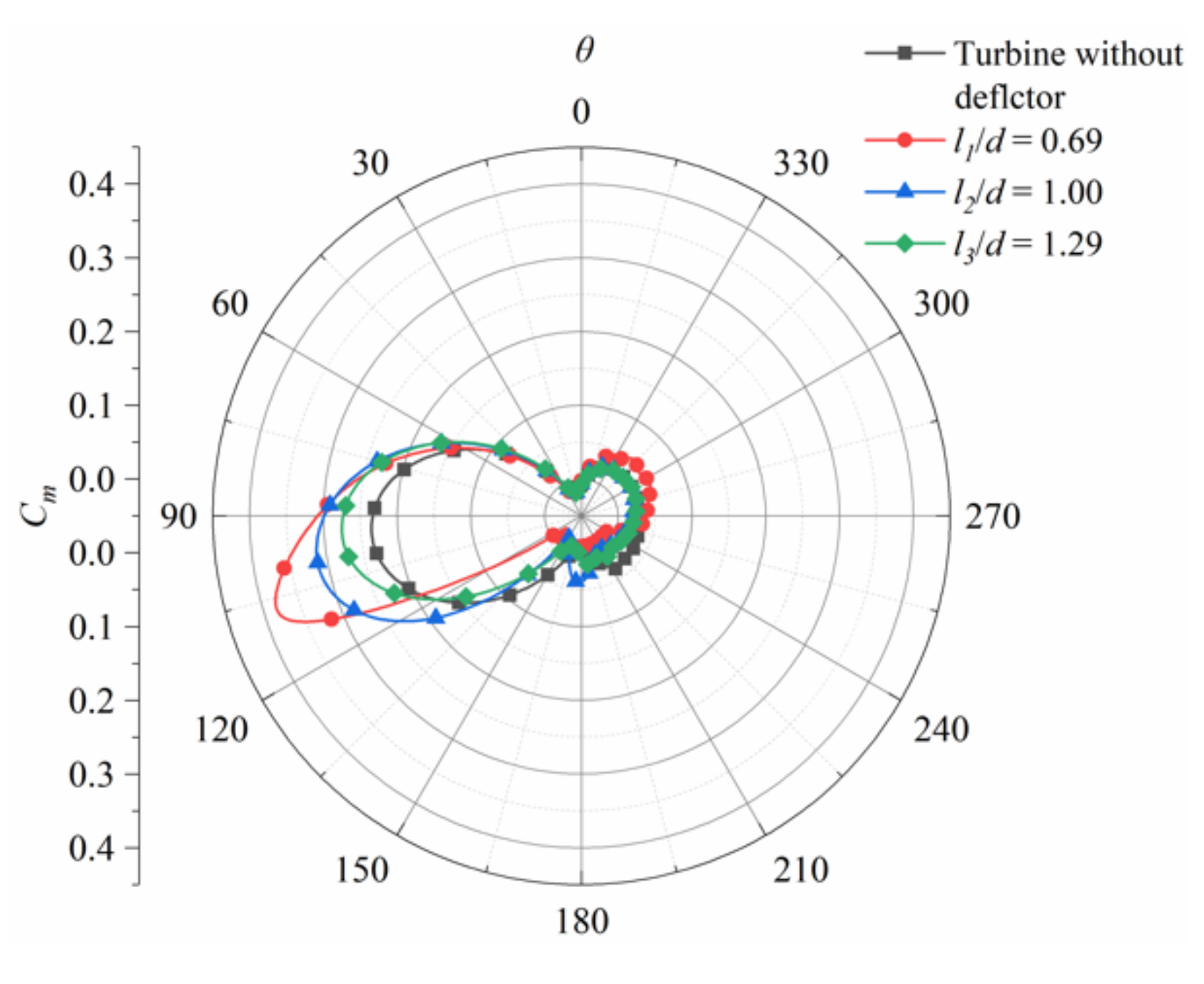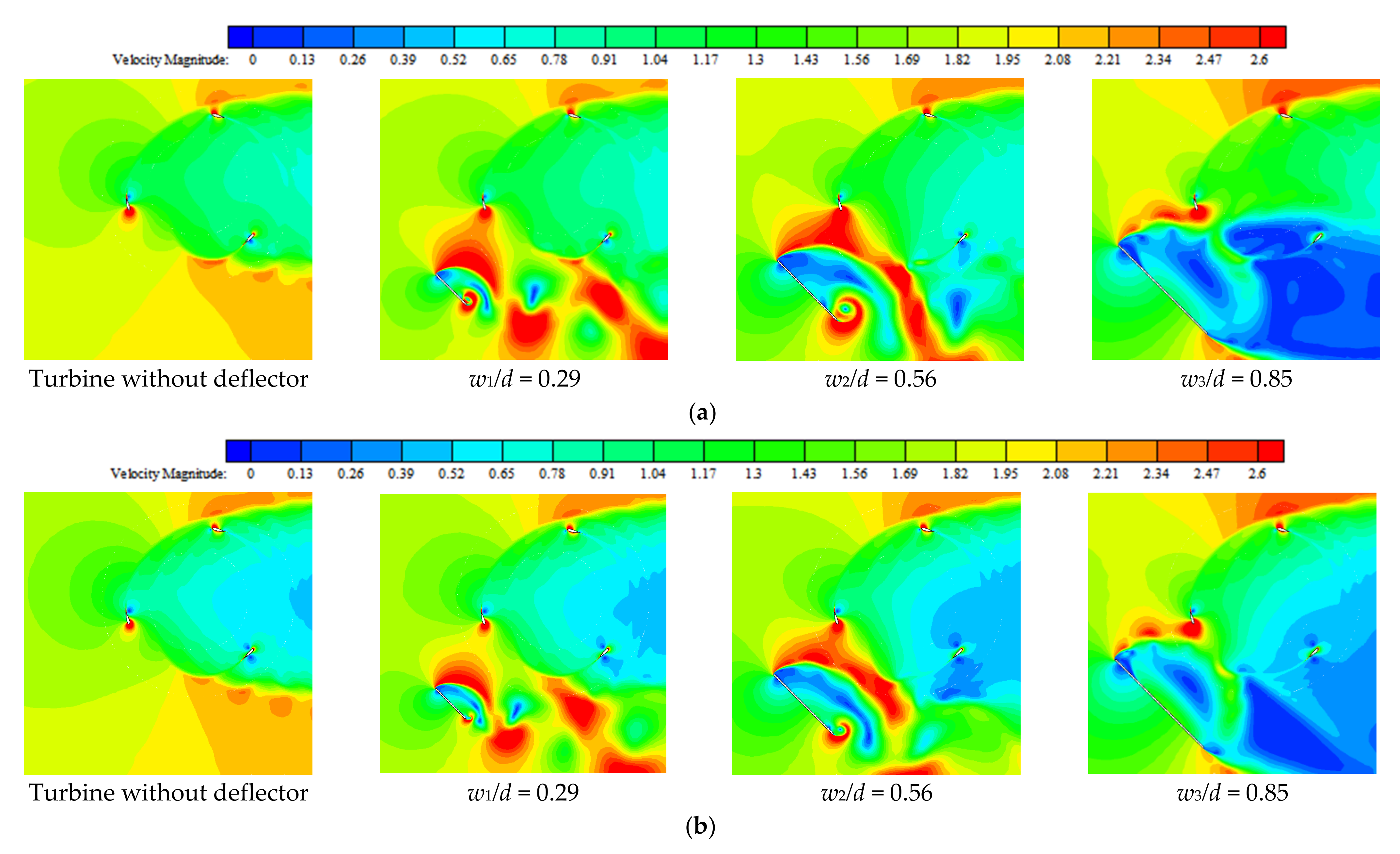Influences of Geometrical Parameters of Upstream Deflector on Performance of a H-Type Vertical Axis Marine Current Turbine
Abstract
:1. Introduction
2. Numerical Methodology
2.1. Hydrodynamic Parameters of VAMCT
2.2. Geometrical Parameters of the Turbine and CFD Simulation Strategy
2.3. Mesh Independency Study
2.4. Model Validation
3. Results and Discussions
3.1. Spatial Arrangement of Upstream Deflector Relative to the Turbine Rotor
3.2. Effect of the Distance between Deflector and Turbine Rotor
3.3. Effect of the Deflector Length
3.4. Effect of Installation Angle of the Deflector
4. Conclusions
- When the deflector is too close to the rotor, the low-speed flow behind the deflector has a negative effect on the hydrodynamic performance of the turbine and the averaged power coefficient obviously decreases. When the deflector is away from the turbine, the influence of the accelerating fluid on the blade is weakened, so there exists a proper distance between the deflector and the rotor, which greatly improves the averaged power coefficient of the VAMCT.
- With the increase in the deflector length, more accelerated fluid is guided to the turbine. At the same time, the low-speed fluid region behind the deflector is also extended, and it would deteriorate the energy extraction efficiency of the turbine. Therefore, it is crucial to choose a deflector with an appropriate length to improve the averaged power coefficient of the VAMCT.
- The installation angle of the deflector has a significant impact on the hydrodynamic performance of the turbine. Although the deflector with β = 67.5° and 112.5° can improve the performance of the vertical axis marine current turbine, the effect of the low-speed region behind the deflector causes the fluctuation amplitude of the moment coefficient to increase, which is not conducive to the safe and stable operation of the turbine.
- In this paper, a proper combination of deflector parameters, namely, l/d = 1.00, w/d = 0.56, and β = 45°, was identified. Compared with the turbine without a deflector, a maximum increase of 13.37% is achieved at the optimal tip speed ratio λ = 2.4. In future works, further optimization of the geometry parameters of the deflector would be performed by using orthogonal array design, and the shape of the deflector will also be considered.
Author Contributions
Funding
Conflicts of Interest
Nomenclature
| θ | Azimuth angle |
| c | Hydrofoil chord length |
| Cp | Averaged power coefficient |
| λ | Tip speed ratio |
| l | Distance between deflector and rotor |
| β | Deflector installation angle |
| w | Length of the deflector |
| U∞ | Freestream velocity far upstream |
| D | Diameter of the turbine |
| Cm | Moment coefficient |
| Cp | Power coefficient |
| Re | Reynolds number |
| M | Moment of the turbine |
| P | Power of the turbine |
| T | Rotating period |
| ρ | Density of the fluid |
| ω | Angular velocity |
| A | Turbine swept area |
References
- Rourke, F.O.; Boyle, F.; Reynolds, A. Tidal energy update 2009. Appl. Energy 2010, 87, 398–409. [Google Scholar] [CrossRef]
- The, J.; Yu, H.S. A critical review on the simulations of wind turbine aerodynamics focusing on hybrid RANS-LES methods. Energy 2017, 138, 257–289. [Google Scholar] [CrossRef]
- Bhutta, M.M.A.; Hayat, N.; Farooq, A.U.; Ali, Z.; Jamil, S.R.; Hussain, Z. Vertical axis wind turbine—A review of various configurations and design techniques. Renew. Sustain. Energy Rev. 2012, 16, 1926–1939. [Google Scholar] [CrossRef]
- Ma, Y.; Hu, C.; Li, Y.L.; Deng, R. Research on the Hydrodynamic Performance of a Vertical Axis Current Turbine with Forced Oscillation. Energies 2018, 11, 20. [Google Scholar] [CrossRef] [Green Version]
- Ji, R.; Sheng, Q.; Zhang, L.; Dong, Y.; Zhang, X. Experimental study on hydrodynamic model of vertical-axis tidal current turbine with fixed-blade propeller. J. Ocean. Technol. 2018, 37, 72–82. [Google Scholar]
- Xiao, Q.; Liu, W.; Incecik, A. Flow control for VATT by fixed and oscillating flap. Renew. Energy 2013, 51, 141–152. [Google Scholar] [CrossRef]
- Priegue, L.; Stoesser, T. The influence of blade roughness on the performance of a vertical axis tidal turbine. Int. J. Mar. Energy 2017, 17, 136–146. [Google Scholar] [CrossRef]
- Chen, B.; Su, S.; Viola, I.M.; Greated, C.A. Numerical investigation of vertical-axis tidal turbines with sinusoidal pitching blades. Ocean. Eng. 2018, 155, 75–87. [Google Scholar] [CrossRef] [Green Version]
- Wong, K.H.; Chong, W.T.; Sukiman, N.L.; Poh, S.C.; Shiah, Y.-C.; Wang, C.-T. Performance enhancements on vertical axis wind turbines using flow augmentation systems: A review. Renew. Sustain. Energy Rev. 2017, 73, 904–921. [Google Scholar] [CrossRef]
- Naseem, A.; Uddin, E.; Ali, Z.; Aslam, J.; Shah, S.R.; Sajid, M.; Zaidi, A.A.; Javed, A.; Younis, M.Y. Effect of vortices on power output of vertical axis wind turbine (VAWT). Sustain. Energy Technol. Assess. 2020, 37, 11. [Google Scholar] [CrossRef]
- Wong, K.H.; Chong, W.T.; Sukiman, N.L.; Shiah, Y.-C.; Poh, S.C.; Sopian, K.; Wang, W.-C. Experimental and simulation investigation into the effects of a flat plate deflector on vertical axis wind turbine. Energy Convers. Manag. 2018, 160, 109–125. [Google Scholar] [CrossRef]
- Jiang, Y.C.; Zhao, P.D.; Stoesser, T.; Wang, K.; Zou, L. Experimental and numerical investigation of twin vertical axis wind turbines with a deflector. Energy Convers. Manag. 2020, 209, 112588. [Google Scholar] [CrossRef]
- Qasemi, K.; Azadani, L.N. Optimization of the power output of a vertical axis wind turbine augmented with a flat plate deflector. Energy 2020, 202, 10. [Google Scholar] [CrossRef]
- Kim, D.; Gharib, M. Efficiency improvement of straight-bladed vertical-axis wind turbines with an upstream deflector. J. Wind Eng. Ind. Aerodyn. 2013, 115, 48–52. [Google Scholar] [CrossRef]
- Jin, X.; Wang, Y.M.; Ju, W.B.; He, J.; Xie, S.Y. Investigation into parameter influence of upstream deflector on vertical axis wind turbines output power via three-dimensional CFD simulation. Renew. Energy 2018, 115, 41–53. [Google Scholar] [CrossRef]
- Kim, D.; Gharib, M. Unsteady loading of a vertical-axis turbine in the interaction with an upstream deflector. Exp. Fluids 2014, 55, 1658. [Google Scholar] [CrossRef]
- Rezaeiha, A.; Montazeri, H.; Blocken, B. On the accuracy of turbulence models for CFD simulations of vertical axis wind turbines. Energy 2019, 180, 838–857. [Google Scholar] [CrossRef]
- Daroczy, L.; Janiga, G.; Petrasch, K.; Webner, M.; Thevenin, D. Comparative analysis of turbulence models for the aerodynamic simulation of H-Darrieus rotors. Energy 2015, 90, 680–690. [Google Scholar] [CrossRef]
- Balduzzi, F.; Bianchini, A.; Maleci, R.; Ferrara, G.; Ferrari, L. Critical issues in the CFD simulation of Darrieus wind turbines. Renew. Energy 2016, 85, 419–435. [Google Scholar] [CrossRef]
- Menter, F.R. Two-equation eddy-viscosity turbulence models for engineering applications. AIAA J. 1994, 32, 1598–1605. [Google Scholar] [CrossRef] [Green Version]
- Tong, H.; Fang, J.; Guo, J.; Lin, K.; Wang, Y. Numerical Simulation of Unsteady Aerodynamic Performance of Novel Adaptive Airfoil for Vertical Axis Wind Turbine. Energies 2019, 12, 4106. [Google Scholar] [CrossRef] [Green Version]
- Ye, L.; Sander, M. Calisal. Three-dimensional effects and arm effects on modeling a vertical axis tidal current turbine. Renew. Energy 2010, 35, 2325–2334. [Google Scholar]
- Wang, Y.; Sun, X.J.; Zhu, B.; Zhang, H.J.; Huang, D.G. Effect of blade vortex interaction on performance of Darrieus-type cross flow marine current turbine. Renew. Energy 2016, 86, 316–323. [Google Scholar] [CrossRef]
- Sun, J.; Huang, D. Numerical investigation on aerodynamic performance improvement of vertical-axis tidal turbine with super-hydrophobic surface. Ocean. Eng. 2020, 217, 107995. [Google Scholar] [CrossRef]
- Raciti Castelli, M.; Englaro, A.; Benini, E. The Darrieus wind turbine: Proposal for a new performance prediction model based on CFD. Energy 2011, 36, 4919–4934. [Google Scholar] [CrossRef]
- Hashem, I.; Mohamed, M.H. Aerodynamic performance enhancements of H-rotor Darrieus wind turbine. Energy 2018, 142, 531–545. [Google Scholar] [CrossRef]
















| Parameter | Value |
|---|---|
| Rotor diameter | 1030 mm |
| Number of blades | 3 |
| Blade profile | NAC0021 |
| chord | 85.8 mm |
| Re | 300,000 |
| Tip Speed Ratio λ | Total Cell Number | Averaged Power Coefficient Cp | Difference (%) |
|---|---|---|---|
| 2.6 | 164,000 | 0.41808 | - |
| 315,000 | 0.43186 | 3.30 | |
| 582,000 | 0.4368 | 1.14 | |
| 3.2 | 164,000 | 0.34112 | - |
| 315,000 | 0.34208 | 0.28 | |
| 582,000 | 0.34336 | 0.66 |
| Parameter | Value |
|---|---|
| Deflector thickness t (mm) | 10 |
| Ratio of distance between deflector and turbine rotor to turbine diameter l/d | 0.69, 1.00, 1.29 |
| Ratio of deflector length to turbine diameter w/d | 0.29, 0.56, 0.85 |
| Deflector installation angle β (°) | 45.0°, 67.5°, 112.5°, 135.0° |
Publisher’s Note: MDPI stays neutral with regard to jurisdictional claims in published maps and institutional affiliations. |
© 2021 by the authors. Licensee MDPI, Basel, Switzerland. This article is an open access article distributed under the terms and conditions of the Creative Commons Attribution (CC BY) license (https://creativecommons.org/licenses/by/4.0/).
Share and Cite
Zhou, D.; Sun, X. Influences of Geometrical Parameters of Upstream Deflector on Performance of a H-Type Vertical Axis Marine Current Turbine. Energies 2021, 14, 4087. https://doi.org/10.3390/en14144087
Zhou D, Sun X. Influences of Geometrical Parameters of Upstream Deflector on Performance of a H-Type Vertical Axis Marine Current Turbine. Energies. 2021; 14(14):4087. https://doi.org/10.3390/en14144087
Chicago/Turabian StyleZhou, Donghai, and Xiaojing Sun. 2021. "Influences of Geometrical Parameters of Upstream Deflector on Performance of a H-Type Vertical Axis Marine Current Turbine" Energies 14, no. 14: 4087. https://doi.org/10.3390/en14144087





